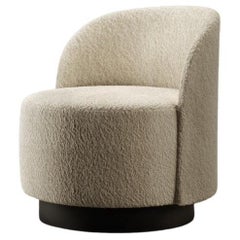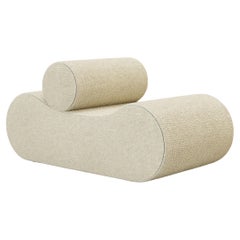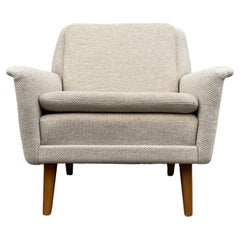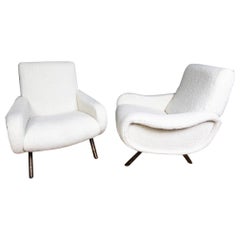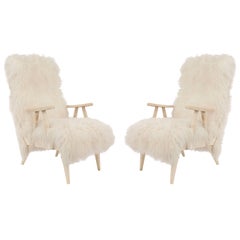White Wool Armchair
to
8
64
17
63
58
27
19
12
6
4
4
3
2
1
1
1
1
4
4
3
3
3
Sort By
DIG IT Armchair Wool bouclé warm White
By Gio Pagani
Located in Milano, IT
version of DIG IT armchair with matt black lacquered Ash wood base is upholstered with White Nimbus By
Category
2010s Italian Modern Armchairs
Materials
Fabric, Wood, Wool
L'EMBLEMATIQUE Contemporary Armchair in White Curly Wool by Alexandre Ligios
By Alexandre Ligios
Located in New York, NY
L'EMBLEMATIQUE Armchair by Alexandre Ligios, Represented by Tuleste Factory
Curly Wool
W 35.4" x
Category
2010s Moroccan Modern Armchairs
Materials
Wool
$2,300
H 25.6 in W 35.4 in D 33.5 in
1930s Art Deco Armchair, Lacquered Beech, Off-White Wool - Belgium
Located in Girona, Girona
Spectacular Art Deco cubist armchair, "Chinese red" lacquered beechwood, new off-white wool
Category
Vintage 1930s Belgian Art Deco Armchairs
Materials
Wool, Beech
$3,556
H 35.04 in W 26.78 in D 29.14 in
Mid Century White Wool "Soriana" Armchairs by Tobia Scarpa Edited by Cassina
By Tobia Scarpa
Located in Ibiza, Spain
Pair of "Soriana" armchairs designed by Tobia Scarpa and edited by Cassina. Structure in chromed
Category
Vintage 1960s Italian Mid-Century Modern Armchairs
Materials
Steel
$15,294
H 29.14 in W 37.01 in D 39.38 in
Vintage Fritz Hansen Armchair in Off White Wool by Folke Ohlsson
By Folke Ohlsson
Located in Esbjerg, DK
Hansen in Denmark during the 1960s. This particular version features off white/ sand colored wool
Category
Vintage 1950s Danish Mid-Century Modern Armchairs
Materials
Wool, Beech
$1,304 Sale Price
20% Off
H 29.14 in W 31.11 in D 28.75 in
Pair of Italian Retrofuturist Armchairs in White Wool and Cube Shape
Located in Ibiza, Spain
Pair of retro-futurist armchairs from Italy dates back to the 1960s and is upholstered in white
Category
Vintage 1960s Italian Armchairs
Materials
Bouclé
$5,809
H 25.6 in W 35.04 in D 34.65 in
Pair of Marco Zanuso Armchair Model Lady in White Thick Wool Fabric
By Marco Zanuso
Located in Milano, MI
Pair of Marco Zanuso armchairs with original structure and thick wool white farbric.
Category
Vintage 1950s Italian Mid-Century Modern Armchairs
Materials
Wool
$11,856 / set
H 31.5 in W 31.11 in D 30.32 in
Late 20th Century White Wool and Solid Wood Pair of Armchairs, Norway
Located in Madrid, ES
Pair of armchairs with structure and legs made of solid wood and reupholstered in white wool
Category
Late 20th Century Norwegian Armchairs
Materials
Wool, Wood
$8,180 / set
H 35.44 in W 37.8 in D 39.38 in
Pair of Mid-Century Lambs Wool Armchairs
Located in Queens, NY
Pair of Mid-Century (possibly Italian) 1950s white shag lambs wool upholstered high back Armchairs
Category
20th Century Italian Mid-Century Modern Armchairs
Materials
Lambskin
Contemporary Armchair 'Divergent' by Marta Delgado, Walnut, White
By Marta Delgado
Located in Paris, IDF
Divergent armchair by Marta Delgado Studio
Fabric: Vintage
Color: White (more colors available
Category
21st Century and Contemporary Portuguese Organic Modern Armchairs
Materials
Wool, Walnut
$6,544 / item
H 29.14 in W 31.5 in D 32.68 in
French Napoleon III Armchair in White Boucle
Located in Houston, TX
French Napoleon III Armchair upholstered in off-white boucle circa 1865-1884. New casters on front
Category
Antique Late 19th Century French Napoleon III Armchairs
Materials
Brass, Steel, Iron
Pair of Italian Contemporary Walnut Armchairs with White Bouclé Upholstery
Located in Ibiza, Spain
Elevate any interior with this stunning pair of contemporary armchairs, handcrafted in solid walnut
Category
21st Century and Contemporary Italian Armchairs
Materials
Wool, Walnut
$6,402 / set
H 29.53 in W 33.08 in D 32.29 in
Franco Albini PL19 or Tre Pezzi Armchair in White Wool by Poggi Pavia, 1950s
By Poggi, Franco Albini and Franca Helg
Located in Montecatini Terme, IT
white Mongolian goat wool.
Designed by Franco Albini & Franca Helg for Poggi, Pavia produced since
Category
Vintage 1950s Italian Post-Modern Armchairs
Materials
Steel
$21,341
H 35.44 in W 29.14 in D 25.6 in
French Napoleon III Armchair in White Boucle
Located in Houston, TX
French Napoleon III Armchair upholstered in off-white boucle circa 1865-1884. New casters on front
Category
Antique Late 19th Century French Napoleon III Armchairs
Materials
Brass, Steel, Iron
Milky White Mara Armchair by Lorenza Bozzoli
Located in Geneve, CH
Milky White Mara Armchair by Lorenza Bozzoli
Dimensions: D 94 x W 106 x H 82 cm. Seat Height: 52 cm
Category
2010s Italian Post-Modern Armchairs
Materials
Other
'Big Big Chair' Armchair by Norr11, Barnum Bouclé, White
By Kristian Sofus Hansen, Norr11, Tommy Hyldahl
Located in Paris, IDF
BIG BIG CHAIR Armchair
Signed by Kristian Sofus Hansen and Tommy Hyldahl for Norr11.
Model
Category
21st Century and Contemporary Danish Scandinavian Modern Armchairs
Materials
Wool
$4,623 / item
H 38.59 in W 37.8 in D 31.89 in
Jan des Bouvri for Gelderland Chrome Base White Woolen Swivel Vintage Armchair
By Gelderland
Located in Markington, GB
Jan Des Bouvri for Gelderland, it is covered in super retro white wool fabric which is in in very good
Category
Mid-20th Century Dutch Mid-Century Modern Armchairs
Materials
Metal, Chrome
$2,054 Sale Price / item
25% Off
H 37.01 in W 30.71 in D 31.89 in
Contemporary Armchair 'Femme Deep' with White Linen by Friends&Founders
By Friends & Founders
Located in Paris, IDF
Contemporary and minimalist armchair named 'FEMME' signed by Danish design studio Friends&Founders
Category
21st Century and Contemporary Danish Modern Armchairs
Materials
Wool, Linen, Foam, Wood
$4,730 / item
H 29.53 in W 33.47 in D 33.47 in
Contemporary Conchula Armchair Set of 2, Swivel, White Bouclé, Greenapple
By Greenapple, Rute Martins
Located in Lisboa, PT
with its refined presence.
The Conchula armchair is upholstered in white bouclé fabric. The fabric can
Category
21st Century and Contemporary Portuguese Modern Armchairs
Materials
Brass
$11,263 / set
H 31.89 in W 37.41 in D 33.47 in
Exceptionally Rare Aino Aalto Chair Model 3920, Birch & White Wool, Artek 1940s
By Artek, Aino Aalto
Located in Helsinki, FI
An exceptionally rare armchair designed by Aino Aalto in 1938, this iconic modernist piece is one
Category
Vintage 1940s Finnish Scandinavian Modern Armchairs
Materials
Wool, Birch
$33,197
H 34.65 in W 25.6 in D 27.96 in
Mid-Century Modern Conchula Armchair, Swivel, DEDAR White Handmade by Greenapple
By Dedar, Rute Martins, Greenapple
Located in Lisboa, PT
with its refined presence.
The Conchula armchair is upholstered in white bouclé fabric. The fabric can
Category
21st Century and Contemporary Portuguese Mid-Century Modern Armchairs
Materials
Brass
$5,691
H 31.89 in W 37.41 in D 33.47 in
Off-White Tweed Armchair with Corten Steel Arms by Benjamin Poulanges France
By Benjamin Poulanges
Located in Paris, FR
Origine armchair, Off-White Tweed Fabric and Corten Steel Arms, made in France, Limited Edition
Category
21st Century and Contemporary French Armchairs
Materials
Steel
$11,856
H 27.96 in W 23.82 in D 31.11 in
Pair of Art Deco Walnut Armchairs With New Black and White Upholstery - Italy
Located in Girona, Girona
black and white flecked wool uphostery.
Italy c. 1930
Category
Vintage 1930s Italian Art Deco Armchairs
Materials
Walnut, Wool
$7,350 / set
H 37.41 in W 28.75 in D 35.44 in
Modern T50 Lounge Chair, White Wool Bouclé, Handmade in Portugal by Greenapple
By Greenapple
Located in Lisboa, PT
, and offer white-glove service as well upon request.
Armchair, Accent Chair, Easy Chair, Wing Chair
Category
21st Century and Contemporary Portuguese Modern Armchairs
Materials
Brass, Stainless Steel
$5,335 / item
H 31.5 in W 25.6 in D 39.38 in
Easy Chair with Tall Back Upholstered in White Fabric, Danish Design, 1960s
Located in Lejre, DK
The armchair with a high back, beautifully upholstered in white fabric and elegantly resting on
Category
Vintage 1960s Danish Scandinavian Modern Armchairs
Materials
Wool, Rosewood
$4,325 Sale Price
20% Off
H 37.41 in W 29.53 in D 31.5 in
Easy Chair with Low Back Upholstered in White Fabric, Danish Design, 1960s
Located in Lejre, DK
The armchair with a low back, upholstered in an elegant white fabric and resting on beautifully
Category
Vintage 1960s Danish Scandinavian Modern Armchairs
Materials
Wool, Rosewood
$3,756 Sale Price
20% Off
H 31.5 in W 29.93 in D 27.96 in
Midcentury White Wool Soriana Sofa and 2 Armchairs By Tobia Scarpa for Cassina
By Cassina, Tobia Scarpa
Located in Madrid, ES
upholstered in white wool, Italian design from the 1960s.
This iconic set of Soriana sofa and armchairs
Category
Vintage 1960s Italian Mid-Century Modern Sofas
Materials
Steel
$30,233 / set
H 27.96 in W 98.43 in D 41.34 in
Roly Poly Armchair in White by Faye Toogood with Casentino cushions
By Driade, Faye Toogood
Located in Brooklyn, NY
Duplex launches DUPLEX X CASENTINO. The iconic Roly Poly armchair designed by Faye Toogood and
Category
21st Century and Contemporary Italian Chairs
Materials
Wool, Plastic
$2,907 / item
H 24.8 in W 33 in D 22.4 in
Vintage Ernest Race Heron Armchair and Footstool in White Bouclé, Britain, 1950s
By Race Furniture, Ernest Race
Located in London, GB
completely re-upholstered in white bouclé wool, with new foam and new Pirelli webbing. Paired with the
Category
Vintage 1950s British Mid-Century Modern Lounge Chairs
Materials
Steel
$4,931 Sale Price
20% Off
H 37.01 in W 32.29 in D 32.68 in
Cove Armchair in Chalk White
Located in London, England
The Cove Armchair is defined by its sculptural and enveloping nature. Planes of beautifully grained
Category
21st Century and Contemporary British Modern Armchairs
Materials
Wool, Bouclé, Oak
PL19 or Tre Pezzi Armchair by Franco Albini in White Mongolian Wool, Poggi
By Franco Albini, Poggi
Located in Montecatini Terme, Toscana
enameled steel tube structure, upholstered in white Mongolian goat wool.
Manufactured by POGGI PAVIA
Category
Vintage 1950s Italian Mid-Century Modern Armchairs
Materials
Steel
$26,084
H 35.44 in W 29.14 in D 25.6 in
Pair of Easy Chair Armchair Thonet Cream White Wool, Black Steel Tube, Germany
By Thonet
Located in Nürnberg, Bavaria
Pair of easy chair / Armchair from Thonet cream white wool and black steel tube, 1960s.
Category
Vintage 1960s German Mid-Century Modern Armchairs
Materials
Steel
$1,422
H 31.5 in W 31.11 in D 24.81 in
Pair of René Herbst Midcentury White Lacquer and Red Wool French Armchairs, 1950
By René Herbst
Located in Madrid, ES
Rene Herbst, chrome, white lacquer and red wool midcentury armchairs, France, 1950.
Category
Vintage 1950s French Mid-Century Modern Armchairs
Materials
Chrome
$6,639 / set
H 33.86 in W 23.63 in D 26.78 in
Contemporary Modern Piet Hein Eek Angora Wool Armchair Timber Natural Cream
By Piet Hein Eek
Located in Amsterdam, NL
Unique Piet Hein Eek fauteuil from 2018.
angora wool upholstery covering a timber frame
Category
21st Century and Contemporary Dutch Armchairs
Materials
Wool
$6,521
H 29.14 in W 25.6 in D 24.81 in
Minimalist Colombia White Bouclé Fabric Armchair by Caffe Latte
By Caffe Latte
Located in New York, NY
Minimalist Colombia White Bouclé Fabric Armchair by Caffe Latte
This Minimalist Colombia White
Category
21st Century and Contemporary Portuguese Modern Armchairs
Materials
Iron, Metal, Aluminum, Bronze, Copper, Steel, Stainless Steel, Chrome, Zinc
$5,870 / item
H 29.53 in W 31.5 in D 28.75 in
Pair of Paola Buffa Mahogany Frame and White Wool Boucle Arm or Lounge Chairs
By Paolo Buffa
Located in Houston, TX
mahogany sculptural arms and upholstered in a white wool bouclé. The pair was purchased with the upholstery
Category
Mid-20th Century Italian Mid-Century Modern Armchairs
Materials
Fabric, Wool, Mahogany
$12,245 / set
H 39 in W 32 in D 35 in
Scandinavian Modern Lounge Chair in Elm and White Wool Nanna Ditzel manner 1950s
By Nanna Ditzel
Located in Beek en Donk, NL
Denmark, designer unknown. The curved shell is professionally re-upholstered in an off-white thick and
Category
Vintage 1950s Danish Mid-Century Modern Armchairs
Materials
Fabric, Elm
$2,940 / item
H 31.5 in W 33.47 in D 32.29 in
Danish Modern Pair of Lounge Chairs in Elm Reupholstered in Off-White Wool
By Nanna Ditzel
Located in Beek en Donk, NL
. The curved seatings have been professionally re-upholsterd with an off-white thick and soft 100% wool
Category
Vintage 1950s Danish Scandinavian Modern Armchairs
Materials
Fabric, Elm
$5,880 / set
H 31.5 in W 33.47 in D 32.29 in
Cove 2.5 Seater Sofa in Chalk White
Located in London, England
wool upholstery is custom made exclusively for the Everyday Collection in collaboration with Tibor and
Category
21st Century and Contemporary British Modern Armchairs
Materials
Wool, Bouclé, Oak
Danish Vintage Lounge Chair in Teak and Re-Upholstered in White and Grey
By Ib Kofod-Larsen
Located in Beek en Donk, NL
Lounge chair in manner of Ib Kofod Larsen with elegant details and new upholstered in a white and
Category
Vintage 1960s Danish Mid-Century Modern Armchairs
Materials
Wool, Teak
$2,608
H 30.71 in W 28.35 in D 27.56 in
Pair of Danish Armchairs in White Wool
By Finn Juhl
Located in Oakland, CA
Pair of mid-century teak armchairs newly upholstered in off-white wool fabric, professionally
Category
20th Century Danish Scandinavian Modern Armchairs
Materials
Teak, Wool
Mid-Century Modern Pair of Armchairs White Bouclé Wool Upholstery, Italy, 1950
Located in Madrid, ES
Pair of armchairs with solid wooden structure and beige wool bouclé upholstery. With wooden legs.
Category
Vintage 1950s Italian Mid-Century Modern Armchairs
Materials
Wool, Wood
$4,683 / set
H 34.26 in W 30.71 in D 29.53 in
Midcentury Pair of Armchairs White Bouclé Wool Upholstery, Italy, 1950
Located in Madrid, ES
Pair of armchairs with solid wooden structure and beige wool bouclé upholstery. With wooden legs.
Category
Vintage 1950s Italian Mid-Century Modern Armchairs
Materials
Wool, Wood
$4,683
H 29.93 in W 29.53 in D 29.53 in
Mid-Century Modern Armchairs in White Linen and Wool Embroidery, Sweden, 1950
Located in Madrid, ES
Mid-Century Modern pair of armchairs made of a solid birch wood structure upholsterd with a white
Category
Vintage 1950s Swedish Mid-Century Modern Armchairs
Materials
Wood, Wool, Linen, Birch
$3,497 / set
H 30.71 in W 23.63 in D 28.75 in
Armchair in White Linen and Wool Embroidery and Brass Legs, Italy, 1950
Located in Madrid, ES
Mid-Century Modern armchair made of a solid birch wood structure upholsterd with a white linen base
Category
Vintage 1950s Swedish Mid-Century Modern Armchairs
Materials
Wool, Linen, Wood, Birch
$2,193
H 33.47 in W 27.17 in D 30.71 in
Armchair in White Linen and Wool Embroidery and Brass Legs, Italy, 1950
Located in Madrid, ES
Mid-Century Modern armchair made of a solid birch wood structure upholsterd with a white linen base
Category
Vintage 1950s Swedish Mid-Century Modern Armchairs
Materials
Wool, Linen, Wood, Birch
$2,122
H 32.68 in W 24.81 in D 27.56 in
Armchair Swedish Baroque Period White Wool Fabric Oak Sweden
Located in New York, NY
Armchair Swedish Baroque oak white wool fabric Sweden. An armchair made in Sweden during the early
Category
Antique 18th Century Swedish Baroque Armchairs
Materials
Oak
Pair of Scandinavian Armchairs with White Wool, circa 1960
Located in Saint-Ouen, FR
. Circa 1960
. Scandinavian
. White wool
. Natural wood
Category
Vintage 1960s Scandinavian Scandinavian Modern Armchairs
Midcentury Scandinavian Armchair Lounge Chair in White Sheep Wool Fabric, 1960
Located in Berlin, DE
This beautiful midcentury Scandinavian armchair or lounge chair was recently reupholstered in white
Category
Vintage 1960s Danish Mid-Century Modern Armchairs
Materials
Fabric, Cherry
$2,489
H 32.29 in W 24.81 in L 32.29 in
Mid-century Jens Risom Walnut Armchair in Black White Wool
By Jens Risom
Located in Oakland, CA
upholstered in a black and white striped wool designed by Tove Kindt Larsen in the 1960's.
Size: SH 18.75.
Category
Mid-20th Century American Mid-Century Modern Armchairs
Materials
Walnut
French Midcentury Armchairs in Walnut and Reupholstered in Off-White Wool Fabric
By Guillerme et Chambron
Located in Almelo, NL
France 1950s. Made of solid walnut and professionally reupholstered in reupholstered in off-white wool
Category
Vintage 1950s French Mid-Century Modern Armchairs
Materials
Fabric, Walnut
$4,950 / set
H 40 in W 23.5 in L 40 in
"Winnie"By Ikea White Yellow Birch Wood Swedish Armchairs, 1950
By Ib Kofod-Larsen, IKEA
Located in Madrid, ES
"Winnie" armchairs by Ikea in birch wood, upholstered in quilted wool cloth by Pierre Frey in beige
Category
Vintage 1950s Swedish Mid-Century Modern Armchairs
Materials
Wool, Wood, Birch
$2,074
H 28.35 in W 21.66 in L 28.35 in
Pair of Maurizio Tempestini Armchairs in Elm and White Bouclé, Italy, 1940s
By Maurizio Tempestini
Located in The Hague, NL
This rare pair of armchairs was designed by Maurizio Tempestini in the late 1940s. The elm wood
Category
Vintage 1940s Italian Mid-Century Modern Armchairs
Materials
Fabric, Wool, Upholstery, Wood, Elm
$15,768 / set
H 30.32 in W 30.32 in D 33.86 in
Pair Edward Wormley Ash & White Wool A-Frame Arm Chairs
By Edward Wormley, Dunbar Furniture
Located in Chicago, IL
white wool seats. Three ash wood structures make up this iconic chair; the curved back with it's cane
Category
Vintage 1950s American Armchairs
Materials
Brass
Marco Zanuso by Arflex Midcentury Martingala Pair of White Italian Armchairs
By Arflex, Marco Zanuso
Located in Madrid, ES
Pair of armchairs model "Martingala" designed by Marco Zanuso (1916-2001) and produced by Arflex
Category
Mid-20th Century Italian Mid-Century Modern Armchairs
Materials
Brass, Steel
$14,820 / set
H 34.65 in W 30.32 in D 31.5 in
Marco Zanuso by Arflex Mid-Century Modern Mod. Martingala White Italian Armchair
By Arflex, Marco Zanuso
Located in Ibiza, Spain
Armchair model "Martingala" designed by Marco Zanuso (1916-2001) and produced by Arflex. Made with
Category
Mid-20th Century Italian Mid-Century Modern Armchairs
Materials
Brass, Steel
$6,402
H 36.23 in W 30.32 in D 31.5 in
Jean Prouvé Fauteuil Direction in White and Grey wool by Vitra
By Jean Prouvé, Vitra
Located in Amsterdam, NL
Iconic Fauteuil Direction designed by Jean Prouvé in 1951 and manufactured by Vitra in 2019. White
Category
Vintage 1950s German Mid-Century Modern Armchairs
Materials
Steel
Marco zanuso pair of vintage lady chairs newly recovered in White wool chine
By Marco Zanuso
Located in Auribeau sur Siagne, FR
Marco zanuso pair of vintage lady chairs newly recovered in White wool chine
Category
Vintage 1950s Italian Armchairs
Materials
Brass
H 31.5 in W 32.29 in D 31.5 in
- 1
Get Updated with New Arrivals
Save "White Wool Armchair", and we’ll notify you when there are new listings in this category.
White Wool Armchair For Sale on 1stDibs
With a vast inventory of beautiful furniture at 1stDibs, we’ve got just the white wool armchair you’re looking for. A white wool armchair — often made from fabric, wool and wood — can elevate any home. If you’re shopping for a white wool armchair, we have 30 options in-stock, while there are 4 modern editions to choose from as well. There are many kinds of the white wool armchair you’re looking for, from those produced as long ago as the 18th Century to those made as recently as the 21st Century. Each white wool armchair bearing Mid-Century Modern, Scandinavian Modern or Art Deco hallmarks is very popular. Marco Zanuso, Arflex and Jean Prouvé each produced at least one beautiful white wool armchair that is worth considering.
How Much is a White Wool Armchair?
Prices for a white wool armchair can differ depending upon size, time period and other attributes — at 1stDibs, they begin at $593 and can go as high as $19,600, while the average can fetch as much as $4,764.
More Ways To Browse
Double Breasted Long Coat
Artifort Penguin
Borge Mogensen Sled Chair
Bronze Moose
Jio Mobler
Folke Ohlsson 4410
Hans Olsen 800
Knoll And Drake
Pierre Paulin Spider
Roly Poly Armchair In Yellow
Roly Poly Pink
Tibor Reich
Aero Dining Tables
Casentino Cushion Roly Poly
Moose Horn
Pierre Paulin Anneau
Adolf Wrenger
Alligator Throne
